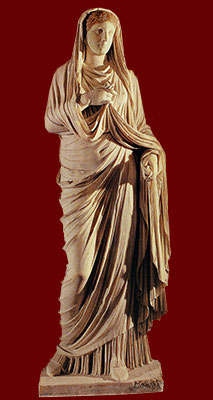
Eumachia, Pompeii
Photo courtesy of
A.O. Koloski-Ostrow

Despite her sex and humble ancestry, Eumachia became one of the most prominent citizens of the city of Pompeii. Having inherited a considerable fortune from her father, Lucius Eumachius, who became wealthy through his brick manufactory, Eumachia married into one of Pompeii's oldest families, the Numistrii Frontones. Her money and new social position enabled her to assume the important public office of priestess and become a patron of the town's corporation of fullers, the dyers and clothing cleaners. One of Eumachia's benefactions was an impressive multi-purpose building (see plan), perhaps the earliest civic structure to be added to the east side of the Forum at Pompeii. She funded and dedicated it, together with her son Marcus Numistrius Fronto, to Concordia Augusta and Pietas. If this building was erected when Numistrius was running for the office of duumvir for the year 2/3 CE, this benefaction was perhaps intended to help gain public support for his election. The function of the large building with its open courtyard and portico is unknown; it may have served as a warehouse for the wool and fulling trade or as an auction house. Its doorway is particularly elegant, faced with fine white marble carved with acanthus leaves reminiscent of the floral panels of the Ara Pacis Augustae in Rome. The niches throughout the building once contained statues; the statue of Eumachia (replica) was found in a large niche off the rear portico. On either side of the entrance small niches held marble tablets celebrating the deeds of Aeneas and Romulus, flanking larger niches that probably once held their statues. The two inscriptions are replicas of those found in the Forum of Augustus, which was completed at the end of the 1st century BCE. The excellence of the sculptural decoration and the building's resonance with themes of Augustan ideology suggest that Eumachia may have been emulating the empress Livia, who built the Aedes Concordiae and, with her son Tiberius, dedicated the Porticus Liviae in Rome to Concordia Augusta in 7 BCE. Eumachia also built for herself and her household a complex, multi-leveled tomb, the largest found in Pompeii, beside the road leading from the Porta Nucera. For further information, see Hemelrijk and Van der Leest in the Bibliography; for other prominent female benefactors see Patrons, Civic Donors and Sacerdotes extra Romam).
EVMACHIA L[uci] F[ilia] SACERD[os] PVBL[ica] NOMINE SVO ET
M[arci] NVMISTRI FRONTONIS FILII CHALCIDICVM CRYPTAM PORTICVS CONCORDIAE
Click on the underlined words for translation aids and commentary, which will appear in a small window. Click on the icon link
![]() to the right of the text for related images and information.
to the right of the text for related images and information.